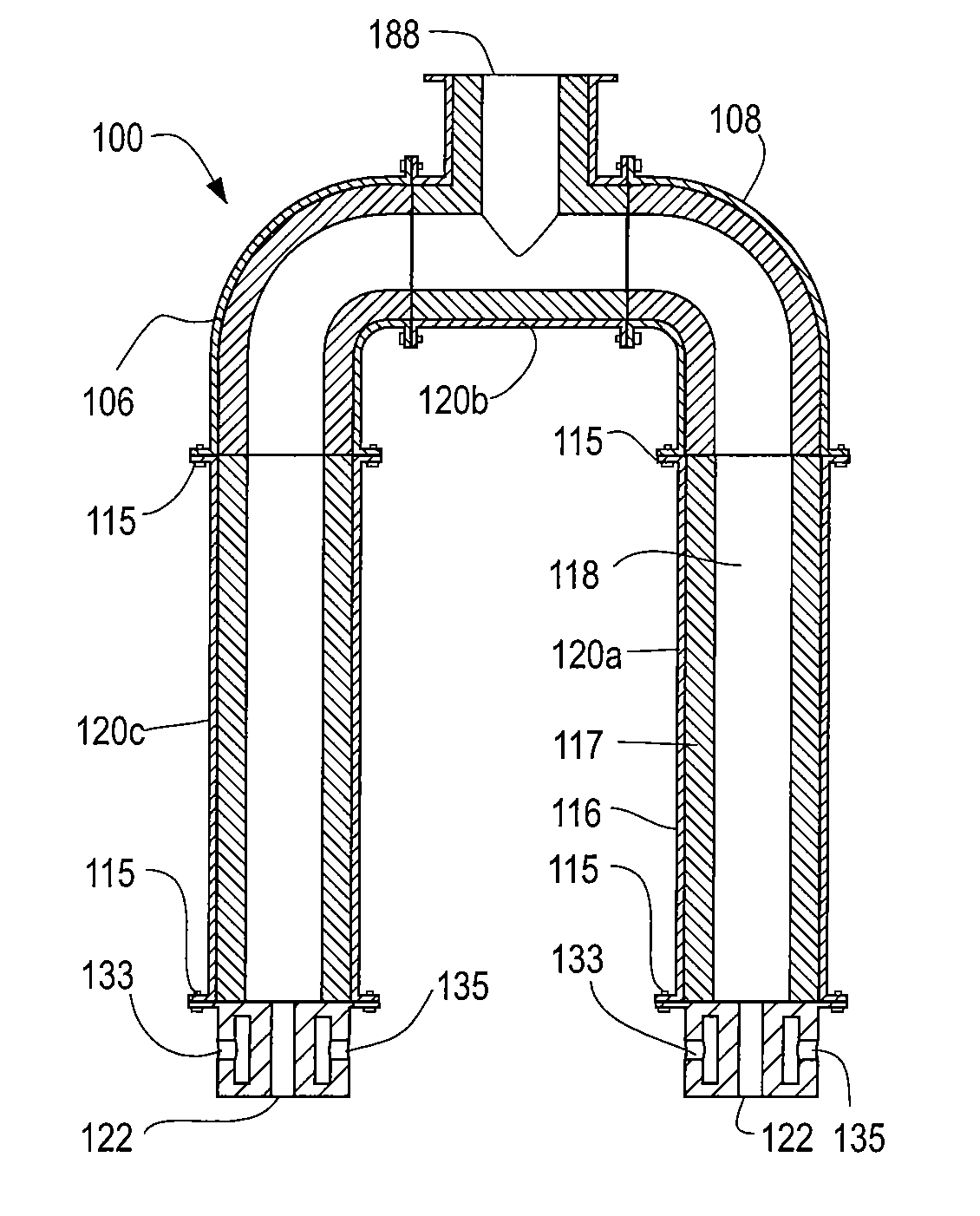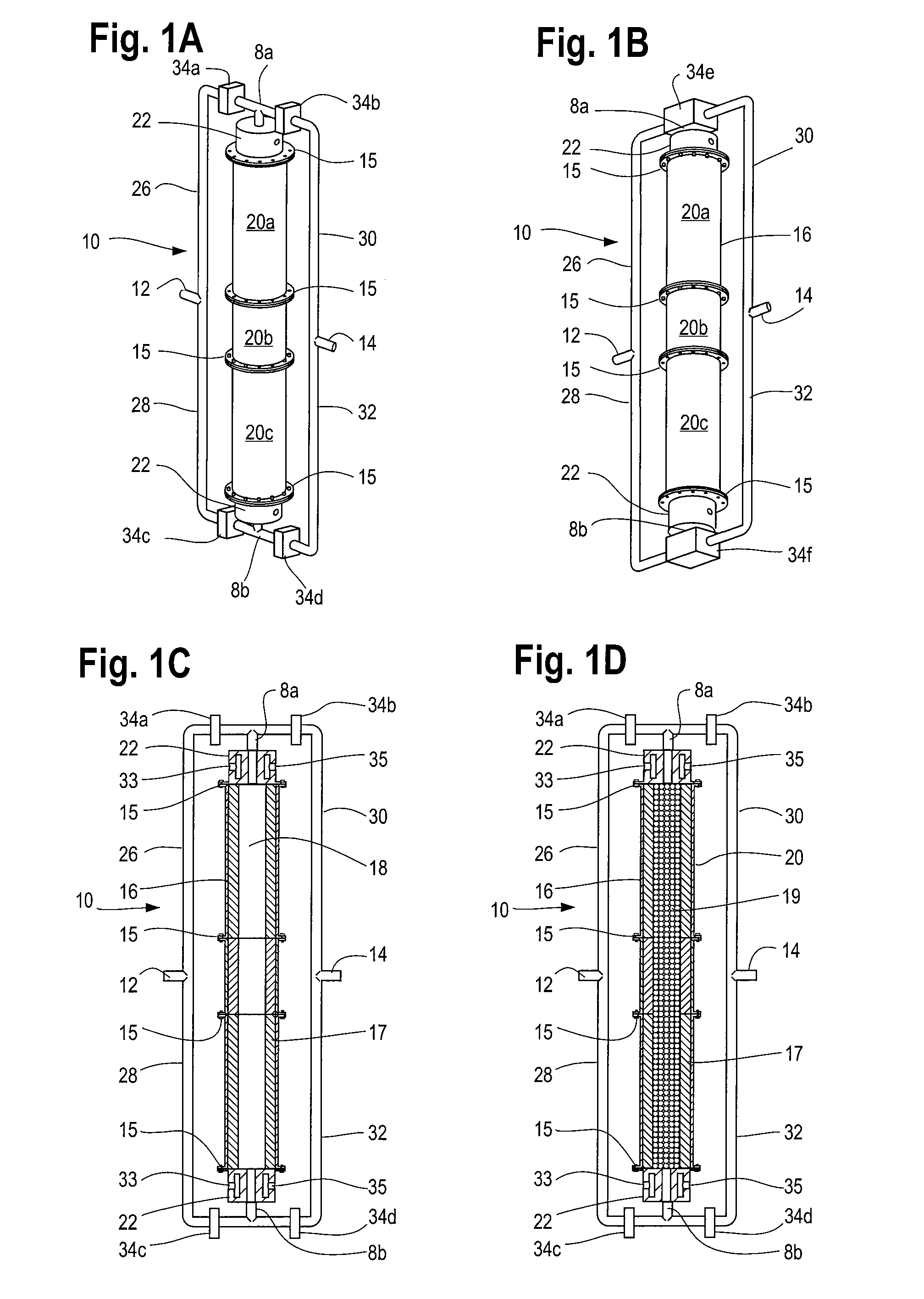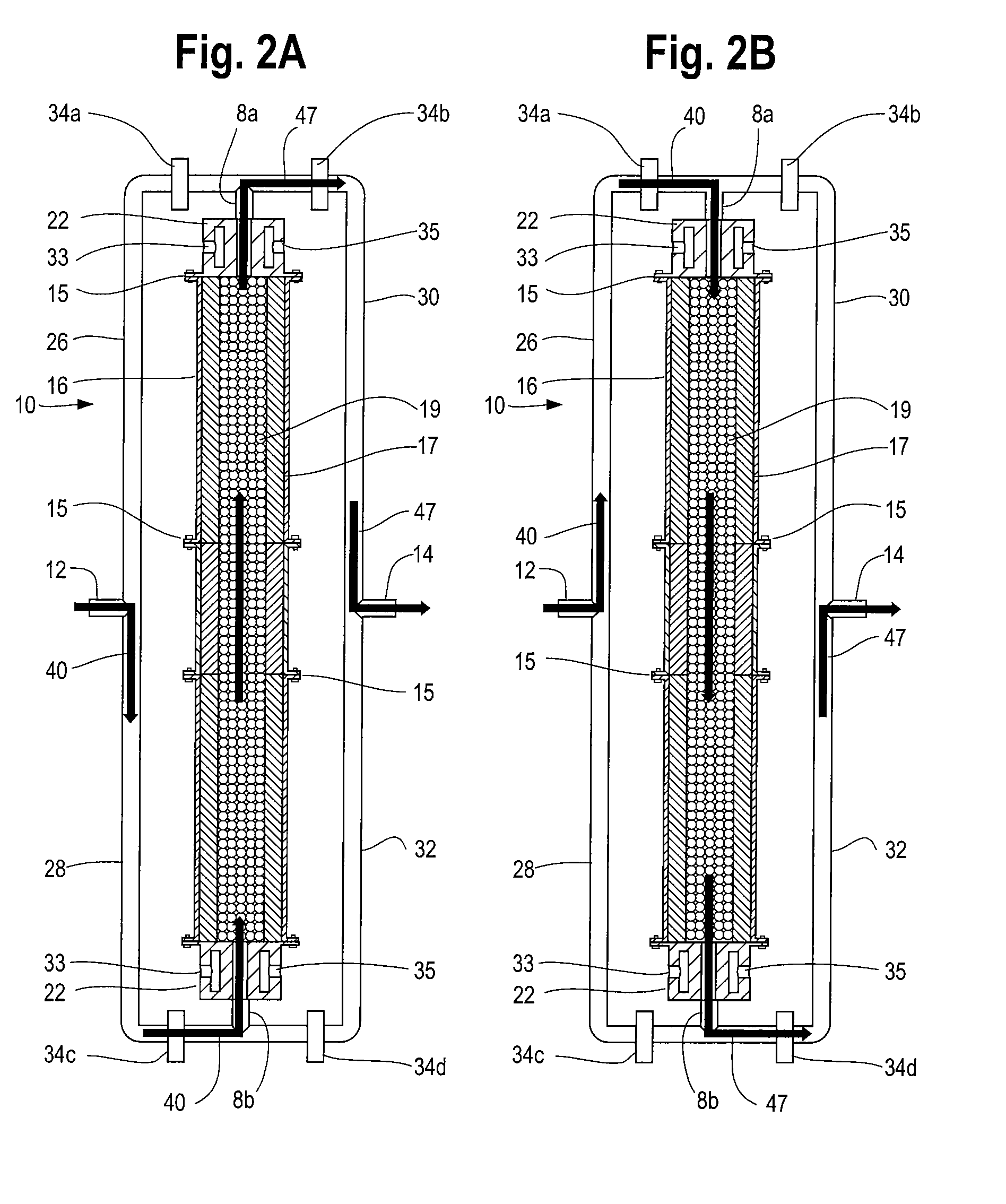[0012]The process of continuously reforming hydrogen containing fluids with an oxidizer in a cyclic flow
reactor system generally comprises the steps of heating the reactor chamber filled with a porous media matrix to a high temperature, channeling a reactant mixture through the porous media matrix, reacting the reactant mixture wherein the reacting occurs through a
reaction zone wherein the
reaction zone may be located in any portion of the reactor chamber, and reversing the direction of the reactant mixture flow after a prescribed period of time wherein the current inlet of the reactor serves as the subsequent outlet and the current outlet serves as the subsequent inlet. This flow reversal is used to keep the reaction zone inside the reactor and also assists in increasing the energy efficiency of the reactor
system.
[0013]In the present invention the reaction zone is unconstrained, and thus, allowed to freely propagate around the porous media matrix contained the reactor. Specifically, if the reaction zone travels in the same direction as the incoming reactant mixture, the process can affect the excess
enthalpy concept by using two energy recuperation mechanisms. Without being limited to the mechanism, it is believed the reactor
system works as follows. The first recuperation mechanism is set in motion when the incoming reactant mixture, e.g. the fuels and oxidizers with possible diluents, are preheated by a hot section inside the
inert porous media matrix resulting from energy stored in the porous media matrix by the previous exothermic reactions. The second recuperation mechanism takes place as the reaction zone is displaced into a region that has previously been preheated by the product mixture. When these means of energy recuperation are coupled, the process can produce superadiabatic temperatures where the actual temperature can exceed the theoretical adiabatic temperature of the mixture with its associated energy content. Using these energy recuperating mechanisms and other means,
partial oxidation in an inert porous media matrix can be advantageously employed to reform ultra-rich mixtures of hydrogen containing fluids with oxidizers and / or steam. Of great benefit is the ability of the apparatus and process to reform sulfur-containing hydrocarbons and other fluids. Of still greater benefit is the ability to reform fluids of low heat content, specifically hydrogen
sulfide. For certain processes, such as, without limitation, the
hydrocarbon process, steam can be added to the reactant mixture to produce an even greater yield of hydrogen, with higher efficiency and simultaneous mitigation of carbon in the product mixture.
[0015]For
maximum efficiency in one embodiment, the fuel and oxidizer reactant mixture is rich enough such that the reaction zone propagates in the same direction as the incoming reactant mixture, referred to above as concurrent propagation. In essence, the reaction zone traveling in the same direction as the reactant mixture has two main positive effects: 1) as the hot product mixture gases travels through the inert porous media matrix, the matrix recuperates a portion of the energy liberated during the
exothermic process and accumulates energy inside the porous media matrix, 2) as the reaction zone is displaced through the reactor chamber, the incoming reactant mixture is in turn pre-heated before reaching the reaction zone by the energy accumulated in the inert porous media matrix from previous exothermic reactions. In this manner, the process is much more efficient since it results in a double energy recuperation mechanism. With this intrinsic heat exchange
system, actual temperatures from this
exothermic process normally exceed the theoretical adiabatic temperature. Those skilled in the art normally refer to this effect as the superadiabatic phenomena. One of the advantages of this concurrent reaction zone propagation system is the ability to sustain normal
combustion for mixtures where the fuel content lies below the lower
flammability limit, i.e. where the fuel mixture is ultra-lean. On the other end of the spectrum, the concurrent propagation direction of the reactant mixture and the reaction zone is well suited for fuel reformation of ultra-rich mixtures where the relatively high temperatures are ideal for overcoming kinetic and thermodynamic limitations.
[0016]Even though the reaction front propagates very slowly, on the order of 0.1 mm / s, left alone, it will eventually travel out of the reactor. To prevent the reaction zone from exiting the reactor, the direction of the reactant mixtures may be periodically reversed or “cycled” where the reactor's outlet prior to flow reversal now becomes the inlet and the inlet prior to flow direction reversal is now the new outlet. Although the interchanging of the inlet and outlet of the reactor is a means of keeping the reaction zone inside the reactor, it can also play an important role in increasing the efficiency of the reactor. Such a flow reversal or
cycling, which may or may not be automatic, can also be dictated by the temperature at the outlet of the reactor system. As the reaction zone carries the partial oxidation or
combustion process, the porous media matrix in the post reaction zone area absorbs the energy liberated by the reaction zone. Therefore, the temperature at the outlet of the reactor system increases over a certain amount of time until the temperature at the outlet almost reaches the temperature of the reaction zone. From the point of view of efficiency, it is less advantageous to allow the outlet temperature to reach very high values since a good portion of the energy liberated by the reaction will be lost. An appropriate cyclic period can be derived such that a great portion of the
axial length of the reactor chamber is approximately an isothermal volume after a number of repetitions of flow
cycling. This isothermal volume is conducive to reforming reactions when the
residence time inside the reactor chamber enables the reactions to approach equilibrium. A person of ordinary skill in the art will recognize that the
residence time will vary for different fuels or fluids which are to be reformed.
 Login to View More
Login to View More 


